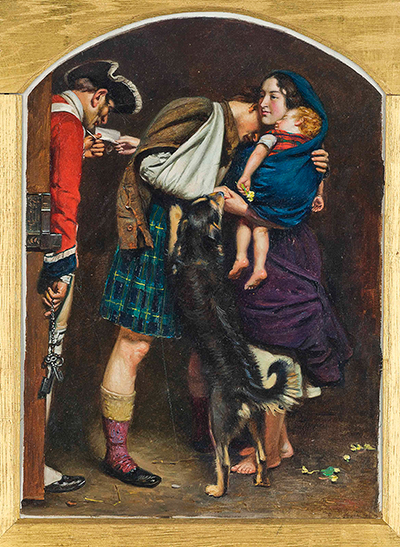The Order of Release by John Everett Millais is an oil on canvas painting, and one of the most famous works produced by this central member of the Pre-Raphaelite Brotherhood.
Painted between 1852 and 1853, the painting features the release of a Scottish rebel soldier into the care of his wife and child. The weary wife, carrying her exhausted child and supporting her husband, hands an order of release to his jailer. While the scene was not based on a real incident, it is believed to have been inspired by the works of Sir Walter Scott. While the painting still demonstrates the technique of using high levels of detail that were typical of Millais' Pre-Raphaelite work, the darkness and obscurity of the painting's background shows that Millais was beginning to alter his artistic techniques, adopting a greater simplicity in his work.
The painting went through several changes during its planning phases. The original title was The Ransom, and in early sketches, the rebel's wife is shown giving money to the jailer instead of the order of release. Millais carried out research into clan tartans in order to give an authentic air to the painting, using Robert McLan's Highland Clans as a reference. He used models to capture the poses of the four figures featured in the painting. A professional male artist's model known as Westall posed as the released prisoner, while Effie Ruskin, Millais' future wife, was the model for the prisoner's wife. A model was also used for the child who appears in the painting, although according to Millais' accounts, this child was badly-behaved and made the process of capturing his image very difficult.
The Order of Release was originally bought by a lawyer, Joseph Arden, although it is unclear whether he commissioned the painting or simply purchased it after viewing. It was originally displayed at the Royal Academy, and was immediately popular with visitors to the gallery; spectators had to be moved on by a policeman who was permanently stationed in front of the painting. The Order of Release now belongs to the Tate Gallery, and is temporarily on loan to the National Gallery of Australia.




